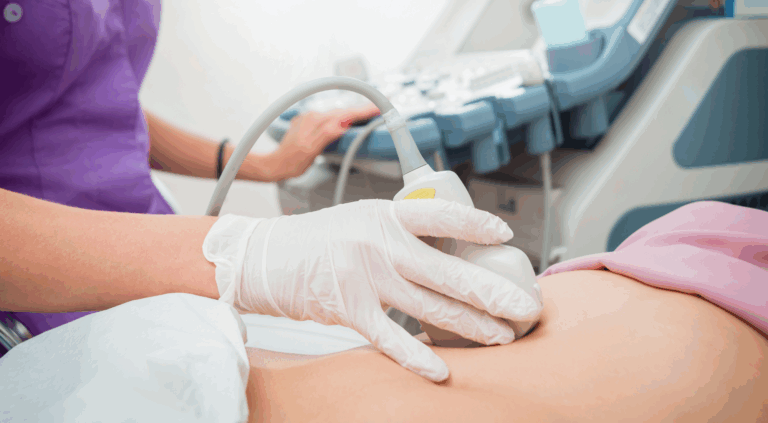
This past year, a woman came to Amnion for an ultrasound after receiving a positive pregnancy test. She wasn’t sure what she wanted to do, caught between the decision to continue the pregnancy or take the abortion pill. As we talked before the ultrasound, she began to lean toward the idea that maybe carrying the pregnancy was the right choice for her.
But once we began the ultrasound, things quickly took an unexpected turn.
At first glance, her uterus appeared empty, with only a thickened endometrial lining. I continued scanning and soon saw what looked like a gestational sac, a fetal pole, and even a flickering heartbeat – but it wasn’t in the uterus. It was in the fallopian tube.
I double-checked. The uterus was clearly empty. Returning to the adnexa, I confirmed the pregnancy was ectopic (positioned in the fallopian tube) and measured at 6 weeks and 6 days with a heart rate of 151 beats per minute. Medically, the baby was developing exactly as expected, except for one devastating detail: it was growing in the wrong place.
She was sent straight to the emergency room and had surgery later that day to remove the ectopic pregnancy and her fallopian tube. Tragically, this also meant the loss of her baby.
In my 18 years working in obstetrics as a nurse practitioner, I had never before seen a live pregnancy in the fallopian tube. Witnessing that heartbeat outside the womb was deeply sobering. One of my first thoughts was, “Thank God she hadn’t taken the abortion pill.” If she had, she might have started bleeding and believed the abortion was complete. But the baby, growing in her fallopian tube, would not have been expelled. The result could have been a life-threatening infection or sepsis. In some cases, this can lead to maternal death.
This is exactly why ultrasounds are so critical before making any decisions about abortion.
Not all ectopic pregnancies progress as far as this one did. But no matter the size of the baby, the risks of rupture and infection are always present. If the abortion pill doesn’t successfully end the pregnancy, which it doesn’t always do, or if the pregnancy is ectopic and therefore not affected by the medication at all, the woman may not realize she’s still in danger. Symptoms may be subtle. And as the pregnancy grows in a fallopian tube not designed to hold it, the risk of rupture and internal bleeding increases significantly.
Mifepristone, the second pill in the abortion pill regimen, cannot remove a pregnancy that is outside the uterus. It won’t expel a baby located in the fallopian tube, even if the medication successfully ends the baby’s life.
This woman’s story made the risks of ectopic pregnancy and chemical abortion vividly real, not only for her, but for me too. Though the day was filled with emotion and uncertainty for her, she was ultimately relieved that her ultrasound revealed what could have become a life-threatening complication. It may not have been the outcome she hoped for, but it very well may have saved her life.
================
Are you facing a similar decision? If you or someone you know is struggling with questions about pregnancy, abortion, and options, Amnion offers a safe place with experienced client advocates to discuss options, and provide resources and materials to support you in this season.
We offer free and confidential medical testing, counseling care and compassionate support. All of Amnion’s services are FREE and confidential. Request to schedule an appointment today – or call 610.622.9957 or email info@amnion.org for more information.